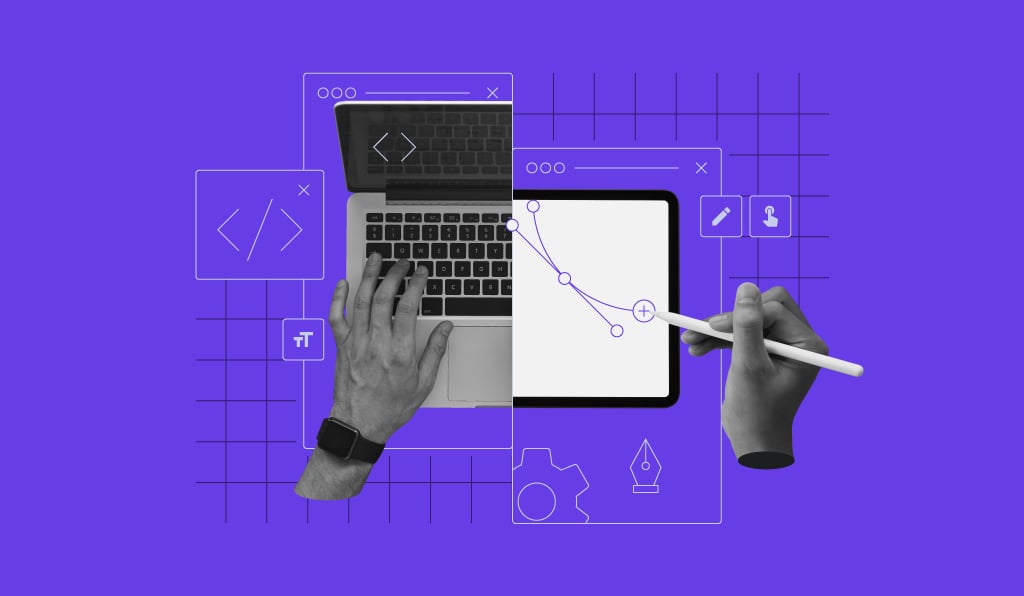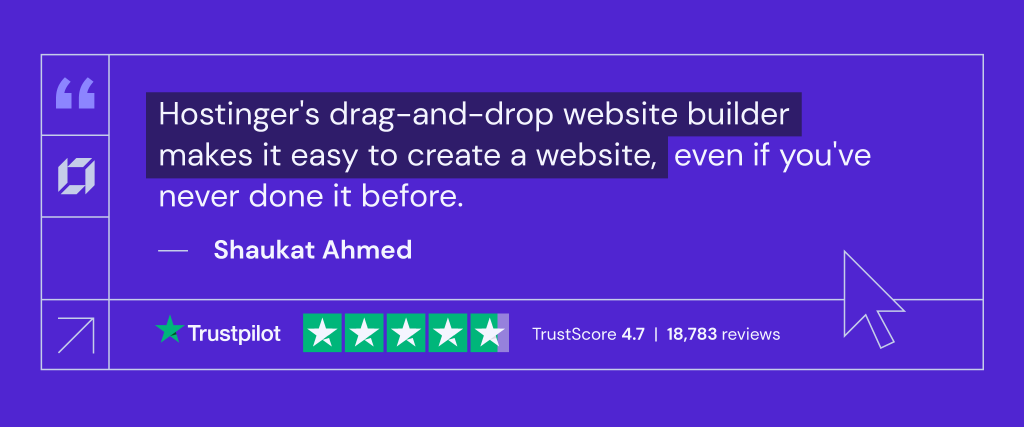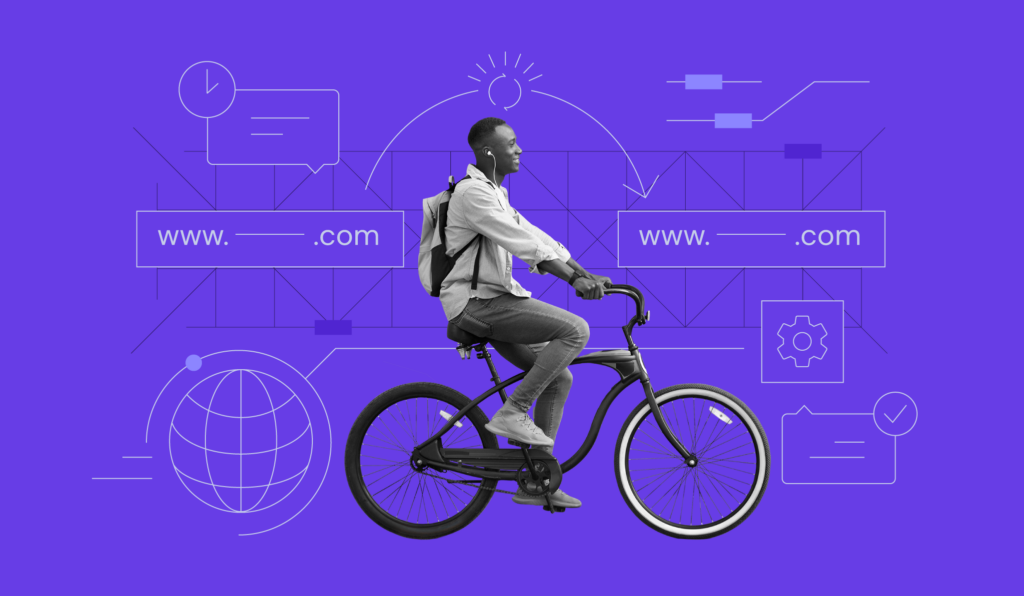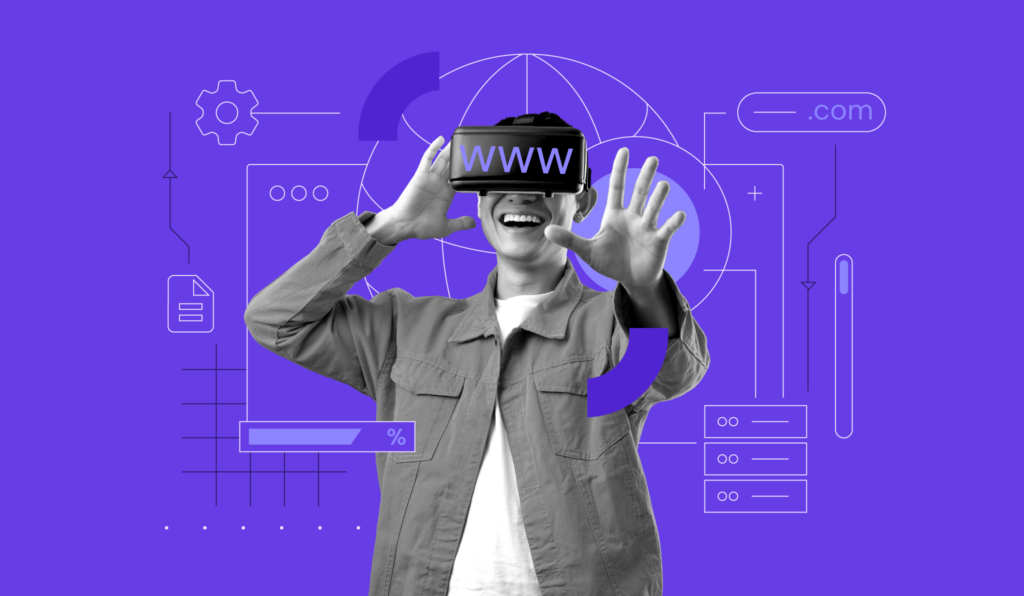Top Web Design Trends for 2024 + AI Trends and Future Trend Predictions

As web design and its best practices are ever-evolving, web designers need to constantly adapt to new challenges and opportunities.
In 2024, several web design trends and AI developments have reshaped how websites are created and experienced.
From typography to sustainability and artificial intelligence, this comprehensive guide will look at the biggest web design trends defining the industry.

Web Design Trends for 2024
User experience (UX) design is a crucial part of your website design. If you want to capture your visitors’ attention, your website design must be both functional and visually pleasing.
Without further ado, let’s dive into some of the top web design trends for 2024.
1. Bold and Experimental Typography
Typography has always been a crucial web design element, but 2024 is the year for bold and experimental typography.
Web designers are turning to oversized typography, bold fonts, and even retro typography to stand out from the crowd. Besides adding a visual interest, these typographic layouts enhance user experience by making the website easier to read and navigate.
Example
The Adelina template by Hostinger Website Builder is a great example of this trend. The contemporary headline font – MuseoModerno – is fresh and eye-catching while remaining easy to read. Consider opting for similar open-source sans-serif fonts, like Lato or Avenir, for a similar effect.
2. Dark Mode Design
Dark mode is more than just a design trend; it’s an option that enhances website performance and adds to the site’s aesthetic appeal. Offering dark mode design elements helps to reduce eye strain. Furthermore, it can improve the battery life of OLED screens.
Example
Many websites, including Google, support dark mode. Commonly, users can choose between dark or light mode or ask the website to mirror the system settings on their device.
3. 3D and Immersive Elements
3D elements and animations are becoming integral parts of modern website design.
These interactive elements offer a more dynamic and engaging experience for site visitors. From animation techniques that make pages lively to the integration of virtual reality, 2024 is seeing an increase in interactive websites that engage users in a virtual world.
Example
Inboda’s landing page features 3D elements in its hero section, creating additional depth to the design. To achieve a similar effect, consider using 3D modeling software like Blender or Google Web Designer.
4. Sustainability and Eco-Friendly Design
Eco-friendly design elements are making their way into web design. From color schemes that echo natural elements to an overall minimalist design, web designers are increasingly focusing on creating websites that reflect modern values regarding sustainability.
Example
Another Hostinger Website Builder template – Poveda – reflects these current design trends perfectly. From scenic full-length hero images to a green color scheme, Poveda is a great example of how to incorporate your brand identity into your web design naturally.
5. Abstract and Organic Shapes
Breaking away from traditional web design grids, abstract and organic shapes are currently trending in the design world. These shapes add visual interest and make the entire page appear more dynamic and fluid. In 2024, this is one of the popular web design trends offering a more modern design approach.
Example
Rounded corners and circular shapes keep the visitors engaged for longer. Consider adding a mask or rounding the corners of certain images on your pages for a more dynamic browsing effect.
6. Neumorphism (Soft UI)
Neumorphism, or Soft UI, combines skeuomorphism and flat design elements to create soft, easy-to-interact-with, and visually appealing interfaces. This design trend is about subtlety and tactile experience, featuring minimal color contrasts and soft, raised elements.
Example
A soft UI approach works well for brands that value a minimalist and clear look. In addition, neumorphism can be applied to app design as well.
7. Micro Interactions
Micro-interactions, like hover effects and button animations, are crucial in enhancing user engagement. These small design elements make a significant impact on the overall user experience, giving your website a professional look and feel.
Example
Tools like Hostinger Website Builder simplify integrating these micro-interactions into your web design. Add different types of micro-interactions, like animations, to images and icons in the image settings.
8. Emotional Design and Storytelling
Emotional design is becoming a focal point as web designers aim to create experiences that resonate on a deeper level with visitors. Designers can significantly affect visitor engagement by using colors, imagery, and typography that evoke certain feelings or attitudes.
Example
User-friendly websites should not only be intuitive to use but also communicate the key values of your brand. For example, the Kristine template uses rounded heading fonts and soft pinks to create a feminine and gentle atmosphere.
9. Typography and Color Scheme Trends
Bright colors are coming back as designers are stepping away from the monochromatic design style. Typography trends in web design are headed toward an experimental phase with bold, oversized fonts dominating the digital design sphere.
Example
Consider using accent colors to highlight key selling points in your headings. A clear contrast between the background and your typography also enhances readability.
10. Gradients and Color Transitions
Gradients are returning, adding depth and visual interest to otherwise flat designs. This web design trend is visually appealing and aids in directing website visitors’ attention to crucial elements on the page.
Example
Use gradient backgrounds in your hero sections. This helps to highlight your product or headline and ensures the visitors don’t miss any important information.
11. Microcopy and Conversational UI
Concise and friendly microcopy is becoming increasingly important, guiding users through the maze of modern web design. When coupled with conversational UI elements, these small text cues can provide a seamless and user-friendly experience.
Example
On top of using microcopy in loading screens, consider including intuitive onboarding checklists and flows in your web design. This way, you ensure the users won’t miss any important steps that could cause frustration or confusion.
12. Combining Images With Graphic Elements
The trend of combining photographs with graphic elements, such as text and shapes, adds a new layer of depth to web pages. This innovative approach creates a unique, visually appealing experience that engages website visitors.
Example
Overlaying images with text and icons is simple to do with our drag-and-drop site editor. Simply select a text block and place it over an image. Remember to check that the text still remains easy to read. Look for images that have opposing or contrasting colors to your text blocks.
AI Web Design Trends
Artificial intelligence is changing the landscape of web design. From automation and personalization to predictive analytics, let’s explore the current AI web trends in the field.
1. Personalized User Experiences
AI algorithms can process vast amounts of user data in real time, allowing web designers to create highly personalized user experiences. This extends to personalized content recommendations, tailored layout changes, and even product suggestions for eCommerce sites.
2. Automated Layout Generation
Advanced machine learning models can now help generate layouts and design templates that are functional, visually appealing, and optimized for search engines. This trend is streamlining the initial stages of the design process, enabling designers to focus more on fine-tuning and customization.
Using AI tools, like Hostinger’s AI website design generator, significantly simplifies the web design process. These tools can generate layouts and website templates that are both functional and aesthetically pleasing.

3. Chatbot Integration
Chatbots have come a long way, both in terms of natural language processing and contextual understanding. These AI-powered assistants are becoming increasingly sophisticated, capable of handling complex queries and providing detailed answers or solutions. This significantly enhances the user experience, particularly in customer service scenarios.
Businesses like Sephora and H&M employ AI chatbots for product recommendations and customer queries, improving user experience and driving sales.
4. Visual Recognition and Search
AI algorithms can identify objects and features within images, making advanced visual search a reality. This is especially useful for eCommerce platforms where users may want to find products similar to those they have seen in photos.
For instance, Pinterest uses visual search to help users find similar items or themes, adding a new dimension to online search.
5. Predictive Analytics for Personalization
By leveraging machine learning, predictive analytics tools can forecast user behavior based on their past interactions. This is invaluable for offering personalized discounts, content, or suggestions that will most likely engage the user.
For example, heat mapping tools are getting better at analyzing user behavior and engagement metrics. These insights empower website owners to organize the content on their sites in a more noticeable way for site visitors. Besides improving user engagement, it also increases retention rates.
6. Accessibility-First Design
AI can scan websites to identify web accessibility issues like poor contrast or missing alt text and automatically correct them. This trend is making the web more inclusive, ensuring that content is accessible to all users.
7. Dynamic Content Optimization
AI can dynamically optimize content based on how users interact with a website. For example, if a user frequently reads blog posts on a particular topic, AI can highlight similar content on the homepage.
Spotify uses this kind of technology to dynamically adjust and personalize each user’s music and podcast recommendations.
8. SEO Enhancements
Use AI content generators to get unique and SEO-friendly articles that will make your site more visible on search engines.
In addition, AI algorithms can analyze web content to recommend SEO strategies. These AI tools scan through a website to suggest keyword optimization, meta-description updates, and other SEO-related adjustments.
9. Voice Interface Optimization
With the rise of voice-activated devices like Google Assistant and Amazon Alexa, AI-powered voice recognition technology is becoming crucial for web design. This results in more natural and engaging user interfaces.
Websites with voice search functionality increasingly leverage AI to better understand and process natural language queries.
10. Automated A/B Testing
AI can also automate the process of A/B testing, choosing the best-performing designs and features based on real-time user data. This speeds up the optimization process and allows designers to quickly implement changes that improve user experience.
Tools like Optimizely are starting to integrate AI to help automate and refine the A/B testing process.
More on AI
Check out the following tutorials to learn more about using AI for your web design:
How to Design Websites With AI: Using AI to Simplify the Web Design Process + Tips
Best AI Prompts for Web Designers and How to Integrate Them Into the Design Flow
Future Web Design Trend Predictions
As we look beyond 2024, our experts expect several emerging web design trends and technologies to redefine the world of web design further.
1. Enhanced AI Integration
AI for websites is likely to go beyond personalized experiences and automated layouts. We might soon witness real-time content generation based on user intent and behavior, allowing for a dynamically changing interface. This can lead to “living” websites that adapt in real time to individual user needs.
Imagine a news website rearranging its layout and article offerings based on your current interests or a learning platform that adjusts its curriculum based on your learning speed and subject mastery.
2. VR and AR Integration
Virtual Reality (VR) and Augmented Reality (AR) will be integrated into web design more extensively in the future. This will create an interactive and immersive platform for users. These technologies will be particularly useful for businesses showcasing products that require a 3D environment.
Think of VR-based virtual trial rooms on fashion eCommerce platforms or AR-based interactive 3D menus for online food ordering services.
3. Voice-Activated Interfaces
As voice recognition technology becomes more sophisticated, we can expect more websites to offer voice-activated navigation. This will improve accessibility and provide a novel way of interacting with websites.
Future iterations could include advanced voice commands for sorting, filtering, or even creating content – like dictating a product review or blog post directly onto the website.
4. Holographic and 3D Interfaces
With technology companies investing heavily in holography, we might soon interact with websites through 3D holographic interfaces. This will completely change the way we perceive and engage with digital information.
Holographic interfaces could allow users to “step into” a website and navigate around as they would in the physical world. This technology could revolutionize industries like real estate, tourism, and education.
5. Multi-Sensory Experiences
As technology advances, web design could move beyond the visual and auditory to include other senses. Websites may incorporate haptics, smell, and even taste to provide a full-sensory experience.
For example, imagine a food blog where you can actually smell the dish that is being described or an online store for perfumes where the scents can be sampled right from the screen.
6. Biometric Verification and Personalization
The implementation of biometrics like facial recognition and fingerprint scanning could enhance security while allowing deeper personalization.
Think about eCommerce websites that recognize you immediately and tailor your shopping experience accordingly, right down to personalized greetings and customized product suggestions.
7. Ethical and Privacy-Centered Design
As consumers become increasingly aware of their digital rights, there will be a growing trend toward designs prioritizing user privacy and ethics, possibly leveraging blockchain technology for secure, transparent user interactions.
Future web designs could include real-time trackers that show how your data is being used or decentralized social networks that give full control back to the user.
8. UI/UX Web Design Trends: Minimalism and Material Design
The shift towards minimalist web design continues to dominate in UI/UX design trends. With an emphasis on white space, the style leans into creating a user-friendly environment. However, Material Design, a design language developed by Google, is also catching traction for its layered, tactile look. This combination keeps the site fresh and accessible, offering the best of both worlds.
9. eCommerce Design Trends: No Code Tools and Mobile-First Design
For eCommerce websites looking to attract more customers, adopting a mobile-first site design is no longer optional. With an array of no-code tools available, creating a website from scratch has never been easier. These web design tools bring all the elements you need to assemble a highly functional and visually pleasing online store, from DIY features to pre-designed landing pages.
10. Animation Technique and Page Transitions
Animation techniques and smooth transitions continue to make websites more interactive and engaging. Graphic artists specializing in web design are becoming more and more sought-after. Whether it’s SVG animations, handmade elements, or full-fledged parallax scrolling, these web design trends are catching everyone’s eye.
11. Creative Personal Portfolio Design
For a web designer looking to create their portfolio, futuristic web design elements like AR interfaces and other interactive web design elements are trending. The portfolio web design trends of 2024 and beyond are expected to mix digital and handmade aesthetics for a truly unique and memorable look.
12. User-Centric Web Design
Responsive web design trends and mobile-first strategies are moving into an overarching theme of user-centric design. In the near future, design is expected to be all about enhancing user engagement through intuitive navigation and interactive elements. This is especially crucial for eCommerce web design trends, where the user’s experience directly impacts sales and brand loyalty.
Conclusion
From bold typography and white space to the integration of AI, website design trends are shifting towards more dynamic, interactive, and personalized experiences.
When creating your website in 2024, here are the main trends to follow:
- Be visible. Use bright colors, bold fonts, and a gradient background to highlight your products or services.
- Maintain sustainability. Show that sustainability matters to you by using a minimalist design and organic shapes.
- Use AI. From a heatmap and SEO improvements to chatbot integration, utilize AI to improve your user experience and overall web design.
It’s an exciting time to be involved in the world of web design, and it will be fascinating to see where these web design trends take us in the coming years.
Web Design Trends 2024 FAQ
Find answers to some of the most common questions about website design trends in 2024.
Do Web Designers Naturally Spot Emerging Design Trends?
While some web designers have a natural talent for design, staying updated on current trends often requires research, constant learning, and adaptability. To keep your design skills relevant, consider subscribing to industry newsletters and regularly visiting design inspiration websites.
What Are the Most Influential Web Design Trends and Techniques of 2024?
The most influential web design trends of 2024 include responsive design, dark mode, and 3D elements. Virtual reality (VR) experiences and voice user interfaces are also becoming more prevalent.
Where Can I Find Information About the Latest Web Design Trends?
Websites like Awwwards, Smashing Magazine, and Behance feature galleries and articles that showcase the latest visual design trends for websites. Regularly participating in design-related events and conferences also helps stay on top of upcoming trends.
What Are Some of the Most Creative Website Trends in Recent Times?
Parallax scrolling, interactive storytelling, and gamification elements are some of the most creative and visual design trends. To make your website more engaging and memorable, you might consider implementing one or more of these innovative web design ideas while also maintaining user experience and website performance.
What Color Scheme Trends Are Popular for Websites in 2024?
Muted color schemes, dark backgrounds with neon accents, and monochromatic layouts are popular color scheme trends for websites in 2024. To modernize your website’s look, consider adopting one of these popular color schemes, but make sure to test the readability and user experience before finalizing your choice.
















Comments
March 25 2024
Feeling good landing here :-)
March 26 2024
Glad to hear that ?